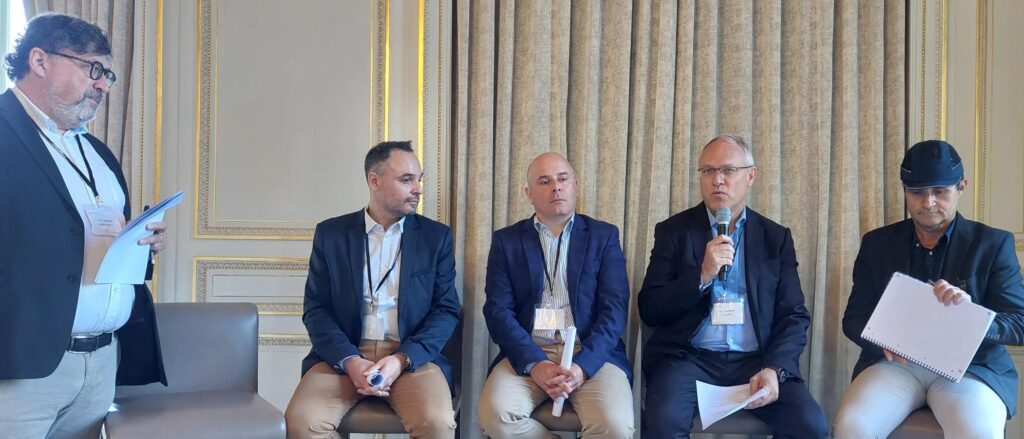Lors d’une table ronde organisée le 13 juin au Crillon à Paris par l’éditeur Transporeon, Olivier Harduin, Senior Manager de Diagma, est intervenu sur les enjeux du suivi en temps réel des flux de transport, sur les bénéfices à en attendre pour les chargeurs et sur les écueils à éviter lors de la mise en place de ce type de solutions logicielles. Avec les témoignages de Cyril Faure, Network Capacity Analyst de Michelin, Jean-Christophe Huon, Directeur Logistique Europe de Limagrain, Frédéric Lanchais, Directeur du commissionnaire Ascot et une animation de Pierre Méraud, Directeur des ventes de Transporeon.

A growing need for real-time transport tracking since COVID
According to Olivier Harduin, Senior Manager at Diagma, the major disruptions during the COVID period, which impacted international transport flows, have significantly increased the need for closer tracking. The main objectives: optimize loading/unloading slots at warehouses and provide customers with accurate information on product availability.
Fortunately, this need has been increasingly met thanks to the availability of effective software solutions on the market. For example, Transporeon’s Real Time Visibility solution allows real-time transport flow tracking. Their Time Slot Management solution also helps optimize appointment scheduling with logistics platforms.
Michelin tracks 60% of its transport flows in real time
Michelin, one of Transporeon’s long-standing clients, decided to implement the Real Time Visibility solution. Aiming to better plan transport flows with its 200 FTL (Full Truck Load) partners, Michelin began testing the tracking solution as early as 2019.
With all its flows managed via Transporeon’s platform, Michelin achieved real-time tracking of 30% of flows by 2022, reaching 60% two years later.
Cyril Faure, Network Capacity Analyst at Michelin, emphasizes the importance of investing in convincing carriers of the added value such solutions provide—even for them. That’s why assigning a project manager on both Michelin’s and Transporeon’s side proved crucial for managing technical and operational issues with transport partners.
A 60% real-time tracking ceiling?
Challenges remain to reach 100% real-time tracking. Some carriers are still reluctant to provide full transparency to their clients. Smaller transporters—especially subcontractors or those covering short distances—often perceive the investment as too high and not directly beneficial to them.
On the other hand, as Frédéric Lanchais, Managing Director at Ascot, points out, some larger carriers may prefer using their own TMS (Transportation Management System) to collect and share fleet data with clients.
This is why the industry often faces difficulties exceeding the 60% tracking threshold.
The complexity of multimodal transport
According to Olivier Harduin, real-time tracking becomes more complex in multimodal transport due to multiple handling units, diverse vehicle/container types, and breakpoints in the chain.
He highlights that most software platforms do not yet cover all transport modes (road, sea, air, rail, and inland waterways) or geographies. Therefore, it’s essential to choose your solution based on your current and future flows, and consider expert support when making these decisions.
Educating carriers is key
How can you convince transporters? As Frédéric Lanchais stresses, nothing is more counterproductive than receiving an impersonal client email mandating connection to a platform.
Instead, educating transporters, explaining the rationale, engaging them in the process, and answering questions works far better. A collaborative approach between shipper and solution provider also helps overcome technical or psychological barriers.
… Along with other incentive methods
Jean-Christophe Huon, Logistics Director at Limagrain, suggests another incentive: asking carriers to update transport order statuses as a condition for invoicing.
This way, automated tracking allows faster payments and reduces manual data entry. Another approach: include real-time tracking as a requirement during transport tenders and formalize it within contracts.
The role of the freight forwarder, redefined
According to Olivier Harduin, there’s significant added value for carriers in improving the efficiency of transport operations. Gone are the noisy offices filled with 30 people spending their days answering customer calls about shipment statuses.
Automated real-time tracking frees up freight forwarders to focus on real issues—like truck accidents or containers held at customs. “This upskilling of the freight team helps to elevate the role internally,” adds the Senior Manager at Diagma.
A more constructive dialogue with carriers
Another benefit of real-time transport visibility solutions is the ability to access performance dashboards. “This enables shippers to engage with their carriers based on factual data and help them grow,”
explains Olivier Harduin. Jean-Christophe Huon from Limagrain adds that having robust KPIs (Key Performance Indicators) allows shippers to evaluate carriers using reliable metrics. This leads to more constructive discussions—for example, taking into account delays that are actually the shipper’s responsibility.
Successfully managing the transformation toward real-time transport tracking
According to Olivier Harduin, given the ongoing and worsening driver shortage, carriers are increasingly able to choose the shippers they want to work with. In this context, the efficiency and quality of the relationship with the shipper significantly enhance their attractiveness.
For him, transport digitization projects generate significant productivity gains. They improve performance—in terms of cost, quality, and lead times—through better flow control. Automation also allows teams to focus on higher-value tasks. Lastly, these projects contribute to reducing CO₂ emissions.
However, such initiatives are true transformation projects that require dedicated resources and budget, and must be designed to evolve over time.

A project in mind? Need advice?
Other articles on related topics:
TRANSPORT TENDERS: TAKE THE PLUNGE!
ELECTRIC VEHICLES: MAKE THE RIGHT CHOICES